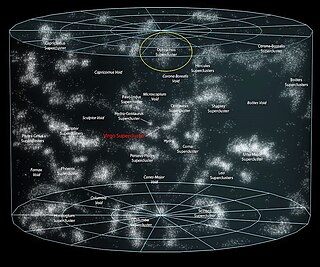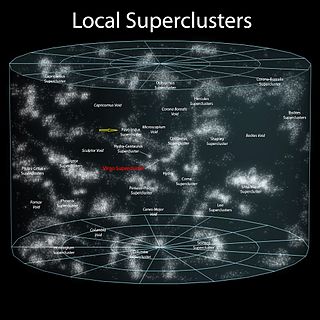 W
WA supercluster is a large group of smaller galaxy clusters or galaxy groups; it is among the largest known structures of the universe. The Milky Way is part of the Local Group galaxy group, which in turn is part of the Virgo Supercluster, which is part of the Laniakea Supercluster. The large size and low density of superclusters means that they, unlike clusters, expand with the Hubble expansion. The number of superclusters in the observable universe is estimated to be 10 million.
 W
WThe Coma Supercluster is a nearby supercluster of galaxies comprising the Coma Cluster and the Leo Cluster.
 W
WDraco Supercluster (SCL 114) is a galaxy supercluster in the constellation Draco. It is located at a distance of 300 Mpc h−1 on a side of a void of diameter of about 130 Mpc h−1. The near side of the void is bordered by the Ursa Major supercluster. The estimated size of the supercluster reaches 410 million light years and a mass of 1017 M☉, making it one of the largest and most massive superclusters known in the observable universe.
 W
WThe Giant GRB Ring is a ring of 9 gamma-ray bursts (GRBs) that may be associated with one of the largest known cosmic structures. It was discovered July 2015 by a team of Hungarian and American astronomers led by L.G. Balazs while analyzing data from different gamma-ray and X-ray telescopes, in particular the Swift Spacecraft.
 W
WThe Hercules Superclusters refers to a set of two nearby superclusters of galaxies.
 W
WThe Horologium-Reticulum Supercluster, is a massive supercluster spanning around 550 million light-years. It has a mass of around 1017 solar masses, similar to that of the Laniakea Supercluster, which houses the Milky Way. It is centered on coordinates right ascension 03h 19m and declination −50° 02′, and spans an angular area of 12° × 12°.
 W
WThe Hydra-Centaurus Supercluster, or the Hydra and Centaurus Superclusters, is a supercluster in two parts, the closest neighbour of Virgo Supercluster.
 W
WThe Hyperion proto-supercluster is the largest and earliest known proto-supercluster, 5,000 times the mass of the Milky Way and seen at 20% of the current age of the universe. It was discovered in 2018 by analysing the redshifts of 10,000 objects observed with the Very Large Telescope in Chile.
 W
WThe Local Supercluster, Local SCl, or Laniakea Supercluster, is the galaxy supercluster that is home to the Milky Way and approximately 100,000 other nearby galaxies. It was defined in September 2014, when a group of astronomers including R. Brent Tully of the University of Hawaii, Hélène Courtois of the University of Lyon, Yehuda Hoffman of the Hebrew University of Jerusalem, and Daniel Pomarède of CEA Université Paris-Saclay published a new way of defining superclusters according to the relative velocities of galaxies. The new definition of the local supercluster subsumes the prior defined local supercluster, the Virgo Supercluster, as an appendage.
 W
WThe Local Sheet in astronomy is a nearby extragalactic region of space where the Milky Way, the members of the Local Group and other galaxies share a similar peculiar velocity. This region lies within a radius of about 7 Mpc (23 Mly), 0.46 Mpc (1.5 Mly) thick, and galaxies beyond that distance show markedly different velocities. The Local Group has only a relatively small peculiar velocity of 66 km⋅s−1 with respect to the Local Sheet. Typical velocity dispersion of galaxies is only 40 km⋅s−1 in the radial direction. Nearly all nearby bright galaxies belong to the Local Sheet. The Local Sheet is part of the Local Volume and is in the Virgo Supercluster. The Local Sheet forms a wall of galaxies delineating one boundary of the Local Void.
 W
WOphiuchus Supercluster is a nearby galaxy supercluster in the constellation Ophiuchus. The supercluster forms the far wall of the Ophiuchus Void; it may also be connected in a filament, with the Pavo-Indus-Telescopium Supercluster and the Hercules Supercluster. This supercluster is centered on the cD cluster Ophiuchus Cluster, and has at least two more galaxy clusters, four more galaxy groups, several field galaxies, as members.
 W
WThe Pavo-Indus Supercluster is a neighboring supercluster located about 60–70 Mpc (196–228 Mly) away in the constellations of Pavo, Indus, and Telescopium. The supercluster contains three main clusters, Abell 3656, Abell 3698, and Abell 3742.
 W
WThe Perseus-Pisces Supercluster is one of the largest known structures in the universe. Even at a distance of 250 million light-years, this chain of galaxy clusters extends more than 40° across the northern winter sky. The Perseus-Pisces Supercluster is one of two dominant concentrations of galaxies in the nearby universe. This supercluster also borders a prominent void, the Taurus Void, and is part of the Perseus–Pegasus Filament which stretches for roughly a billion light years.
 W
WThe Shapley Supercluster or Shapley Concentration is the largest concentration of galaxies in our nearby universe that forms a gravitationally interacting unit, thereby pulling itself together instead of expanding with the universe. It appears as a striking overdensity in the distribution of galaxies in the constellation of Centaurus. It is 650 million light-years away (z=0.046).
 W
WThe Virgo Supercluster or the Local Supercluster is a mass concentration of galaxies containing the Virgo Cluster and Local Group, which in turn contains the Milky Way and Andromeda galaxies. At least 100 galaxy groups and clusters are located within its diameter of 33 megaparsecs. The Virgo SC is one of about 10 million superclusters in the observable universe and is in the Pisces–Cetus Supercluster Complex, a galaxy filament.